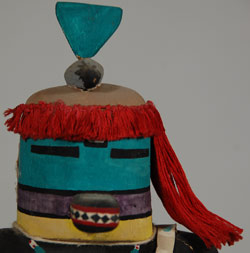Special Value Offer: Hopi Older Unsigned Mosa (Cat) Katsina Doll [SOLD]
+ Add to my watchlist Forward to Friend
- Category: Traditional
- Origin: Hopi Pueblo, Hopituh Shi-nu-mu
- Medium: wood, paint, yarn, leather
- Size: 13-5/8" tall
- Item # C3360S SOLD
Special Value Offer: The estate has agreed to reduce the price by 20% from the original price of $400 to a new price of $320.
Hopi artist Neil David, Sr., in the book Kachinas Spirit Beings of the Hopi, describes this katsina as a Mosa or Cat Katsina. To quote from the text, “Mosa comes from the village of Oraibi, and this is what the artist refers to as a Proud or Kwivi Kachina. He has been described as a form of Tasap or Navajo Kachina, who may be occasionally referred to as a Black Cat Kachina.”
To continue “It is believed by the Hopi that this Kachina was inspired by a Navajo who ran from place to place announcing an approaching ceremony and inviting the neighbors. The Hopi, who customarily received visits from this individual, produced a Kachina called The Old Navajo Kachina. The figure was borrowed from the Hopi by the Zuni, and later, when it was borrowed back by the Hopi, it was renamed the Cat Kachina.”

Others interviewed at Hopi disagree with Neil David on this katsina. Our informant at Kykotsmovi on Third Mesa stated “This is not the Mosa or Cat Kachina. It is the Howit or Hohowit Kachina whose English name is the Proud Kachina.”
An informant at Old Oraibi on Third Mesa stated “This is not a Mosa Kachina and all references to Mosa should be deleted. It is the Proud Kachina. It is similar to the Mosa Kachina but the Cat Kachina is black with white dots. The Cat Kachina in Erik Bromberg’s book is the correct version.” (The painting by Neil David being shown did not have white dots on the body).
Finally, an informant at Shungopavi on Second Mesa stated “This is the Proud Kachina and not Mosa Kachina. The name Cat Kachina comes from the dancer’s motion and sound.”
The above comments by several Hopi were based on showing them the painting by Neil David which did not have the correct markings that they identified with the Cat Katsina, therefore they disagreed with David as to the identity based on the painting.
The Oraibi informant’s comments about Erik Bromberg’s book refer to The Hopi Approach to the Art of Kachina Doll Carving, in which a photograph of a Cat Katsina by Ramon Albert Sr. is identified as the correct version. This carving we are presenting here is more similar to Ramon Albert’s carving than to the painting by Neil David, so we are agreeing with the Oraibi informant and acknowledging that this is a Cat Katsina doll.
This carving by an unknown Hopi carver probably dates to circa 1950s. He features an elegant arrangement of red hair made from fine red yarn. The bandoleer across his chest is made from deer hide as is the concha belt and the ketoh on his left wrist.
Condition: He had cotton glued to the four white spots on his chest and back and the white spot on each of his arms but most of the cotton is missing. He carries a gourd rattle in his right hand but whatever he might have had in his left hand is missing as are the feathers on the right side of the mask. There is a faint crack in the paint behind the right shoulder but it is not significant.
Provenance: from the estate of Michael Frost of Texas
Recommended Reading: Kachinas Spirit Beings of the Hopi, Avanyu Publishing
- Category: Traditional
- Origin: Hopi Pueblo, Hopituh Shi-nu-mu
- Medium: wood, paint, yarn, leather
- Size: 13-5/8" tall
- Item # C3360S SOLD



